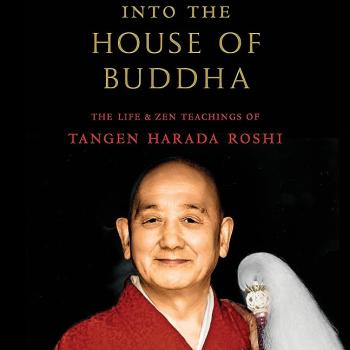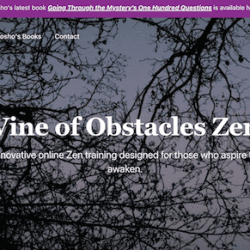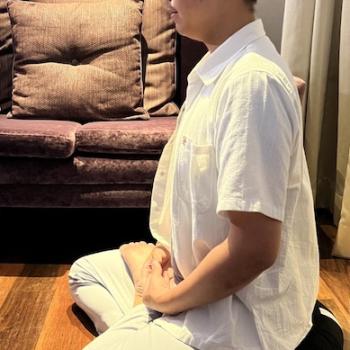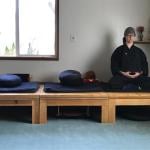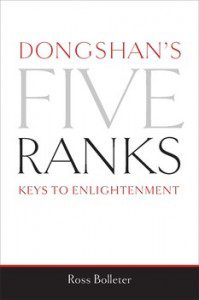 Ross Bolleter, a Zen teacher in the Aitken-Tarrant line who teaches mainly in Australia, has a fine new book on Dongshan’s Five Ranks.
Ross Bolleter, a Zen teacher in the Aitken-Tarrant line who teaches mainly in Australia, has a fine new book on Dongshan’s Five Ranks.
This book will be the constant companion of students who take up the Five Ranks (or Five Modes if you prefer the less hierarchical language) deep in koan introspection or really anyone interested in the system.
Most importantly, Bolleter speaks from inside the ranks – not from the scholarly chair of idle speculation.
Now some apologists for contemporary Soto Zen like to get their kesas tied in a knot about how Dogen was against the Five Ranks and therefore so should we.
Well, that’s a rather thin view that I’d like to challenge.
First, I think we’ll agree that just because Dogen wiped his butt with clay balls doesn’t mean that it is the only way to wipe one’s bottom. He probably had good reason to use clay balls, after all, just like he had good reason to say occasional things about the Five Ranks.
For example, in Shobogenzo Spring and Autumn, he says, “Do not mistakenly say that Dongshan’s buddha dharma is the Five Ranks of oneness and differentiation.”
Fair enough. Let’s hope that Dongshan’s buddhadharma – and all of ours – is not limited to one way of seeing. An old friend, for example, saw all of life in terms of the Myers-Briggs Types Inventory. Of course, there is more to life than fits in that box … and yet it’s interesting to bring up from time to time and reflect on self and other in the Myers-Briggs light. Just not in every conversation about anything. Get’s tiresome.
Just so, there is more to the buddhadharma than the Dongshan’s Five Ranks.
And yet, when the Five Ranks are brought into the koan curriculum (in the Harada-Yasutani system, after the first koan and dozens of checking questions, dozens more miscellaneous koans, and then several classic collections), it seems like time to look at it all again from the Five Ranks’ perspective. At this point, the ranks are not about armchair buddhadharma but cure an ailment of koan introspection – the ailment of over koaning.
But, goodness, what a digression! Back to Bolleter. Let me give you a couple passages that I think are among the most lovely in the lovely book. The first is about the beginning of the process, working with our first koan, cracking open the first rank. The second passage is Bolleter’s summary of the whole process:
1. When we work with the first koan, we find that our most deeply embedded concepts of self and other, and of existence and nonexistence—vital for making sense of, and for making sense in, the world—are exposed as insubstantial. After a time, we are no longer aware of the soft avalanche of notions we once held dear. Eventually we reach a place where we are blocked, and can neither advance nor retreat. In that place, we just renew our questioning. It’s like being in a dark ravine, a mysterious valley. It’s as if we are pregnant, but we can’t give birth. Everything waits, in a dark pause, aching to be breathed out into life. We feel edgeless, looking into a mirror that reflects only darkness. The night moves on little feet, or big feet, depending.
Over time, waiting wears itself out. We come to expect nothing. It is like walking out on a long jetty at night without being able to see hand in front of face, and hearing the sound of water lapping in the darkness. The deeper into a koan we go, the more we leave behind; the more we leave behind, the deeper in we go. This goes on beyond reason. The Way gathers in darkness; it gathers as we struggle to return to our koan, with sleep closing in. For the most part, we don’t notice it gathering. Most of the time we feel a bit desperate, and we may even wonder why we’ve undertaken such an unreasonable, impossible practice. If we’re questioned concerning our koan, we don’t know. When we aren’t being questioned, we still don’t know. It’s important to settle into that not knowing, which should not be confused with the dumb blankness of ignorance. Rather, it is a profound mystery that has not found its tongue. In its own good time, the moon rises and reflects in the water. Meanwhile, we come up to the gate a thousand times. When our time is ripe, under cover of darkness, we go through.
2. Through the five modes of essential and contingent we have discovered that, although we awaken in very individual ways, we can broadly discern staging posts on the path. As we have explored these matters up to this point, we can say that, initially, we experience emptiness, and begin a lifetime’s work of embodying it. We awaken to our intimate connection to all that is, realize the subtlety of words, and then letting go of any preoccupation with hidden understandings, we awaken ourselves, and others, in the thick of the world and its suffering. Finally, we emerge transformed, but find it difficult to say where we have been, or how we have traveled. We live our life—with its give and take, joy and sorrow, increase and decline—as the Way.
Happy Trails!


